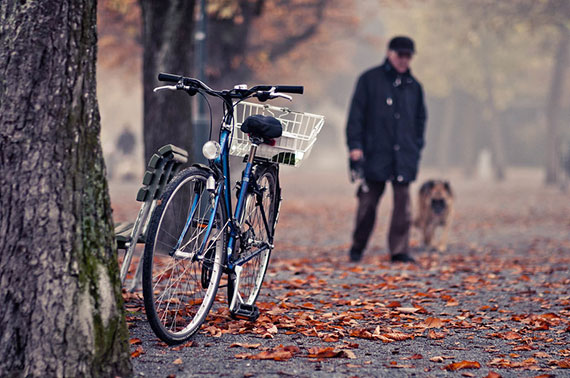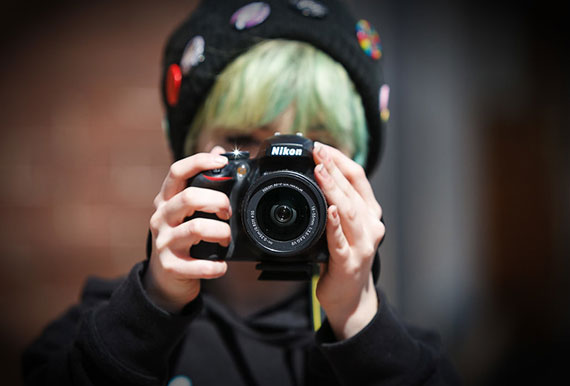Blur or lack of sharpness due to camera shake is a common problem for many photographers. It’s caused by the movement of the hand(s) holding camera itself. It can cause you to take a completely useless photo from a good opportunity.
Luckily, holding a camera correctly is not that hard. You can find many guides all over the internet showing you how you should hold your camera. Since I’m a big fan of simplicity, I will try to tackle this with just one principle that you can apply to every single situation.

Photo by Vaidotas Mišeikis; ISO 200, f/1.4, 1/2500-second exposure.
Let’s start with the worst case, what I will call the fingertip approach. You hold the camera in front of you with your fingertips. Your arm is extended, your fingers are extended, and the camera is shaking.
The basic and important thing to remember is the heavier your camera is, the less likely it is to shake.
Now, before you say, “I don’t want to carry a heavy camera!” well, neither do I. Fortunately, there are ways to make your camera “heavier” without carrying a single gram more.
How? In the fingertip approach, the “weight” of the camera is just itself, say 200 grams for a small compact digital camera. Now try to think of something to combine it with so it gets heavier.
Hmmm…
Found it yet?
For starters, your whole hand! Let’s apply the principle, one step at a time.

Photo by greg Robinson; ISO 100, f/4.0, 1/800-second exposure.
Hold the camera with the palm of your right hand, instead of just with the fingertips. Now, your arm is extended, but you have “integrated” your hand with the camera; they move together. The “weight” of the camera is now the camera plus your hand, say 0.5kg. You have about doubled the “weight,” and this will be a little steadier than the fingertip approach.
One more step. Instead of holding the camera with just your right hand, hold it with both hands. Now, you have a much more balanced platform for your camera; the “weight” of the camera is around 1kg. Be careful not to block the flash or lens with your left hand.
OK, now it’s time to minimize arm movement. Instead of having your elbows at the sides, have them rest on your chest in front of you. Now, you have essentially cut out the movement of the upper arm and fastened the camera a little better to a heavy object—yourself. If you do this, you will want to control your breathing when shooting. It’s surprising how much your lungs move up and down when breathing.
Now the motion of the camera is much more closely tied to your body, and the apparent “weight” of the camera is increased.
The next step is to cut out your motion. If you’re standing up, you will inevitability move a little bit. What you have to do is increase your apparent weight by “integrating” yourself to some heavier object. The technique that I use most often is to find a column or a wall and brace myself against it. You can sit somewhere, lie down on the ground—whatever stops your motion. You can also try to brace just your main shooting hand on a still object.
Obviously, there are different styles for different cameras. SLRs or other cameras with viewfinders, for example, are inherently less prone to camera shake, because in putting your eye to the viewfinder, you often “integrate” them with your head, which is obviously heavier than your hand(s).
For an SLR, I find it best to hold the camera normally with my right hand and place the left side of the camera in my palm so that I am holding the lens with my left hand fingers. (Thumb to the left, fingers to the right of the lens.) When shooting in portrait orientation, I keep the same grip and always tilt the camera to the left (counter clockwise). I find that my right hand is always steadier when tilting to the left. This is what works best for me; you can probably use this as a good starting point to find out exactly how you feel comfortable.
For any camera, and any hand holding situation, just remember the basic principle: make your camera heavier.
About the Author:
Can San writes for notesonphotography.
Like This Article?
Don't Miss The Next One!
Join over 100,000 photographers of all experience levels who receive our free photography tips and articles to stay current:






It is interesting that none of you would think of using whatever is close to you to stabilize the camera.
On the street you can use a mailbox, newspaper box or anything else available, you can also just press your camera into a wall a light post or anything else for vertical shots. All you have to do is use your brain and you’ll get what you want. Of course, if you are a shooter and not a photographer, your photos still going to be bad regardless.
Thank you for this article. It was helpful. I heard things that I’d been told and things I had not been told but tried, such as the breathing and the feet. It was the clearest explanation of how to hold a camera still that I’ve heard or read. Thank you so much.
@ Bevin – Thanks for sharing the insight about target shooting. It’s obvious once you’ve stated it, but I would never have made the connection myself!
Interesting tips indeed!
As I read them one by one, it dawned on me that they almost exactly parallel rifle and target shooting techniques.
Including the breathing during trigger pulls.
Talk about your cross disciplinary skills!
* “rifle and pistol target shooting techniques”
@ St Louis Photographer – Depending on what you’re comparing it to, in many situations you may find the 70-200mm “eats up” light, needs longer exposure times, and therefore is more prone to blur.
I haven’t heard this explained quite this way before. Thinking back, I have noticed that heavier tends to have less motion. Maybe this will justify the 70-200 mm lens. Do you think my wife will go for it?